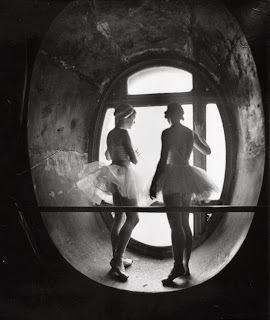When I first moved to NYC in the 1960's, Greenwich Village was hardly the trendy, gentrified playground of the wealthy it has become. It was full of hippies, artists, actors, musicians, playwrights, painters, sculptors - all trying to create whatever-it-was they created - and trying to make a living at it - but, unlike today, not trying to get rich on it.
During that time, every derelict and unrented storefront or backroom or garage was turned into a theatre or concert hall. Makeshift and MakeDo were the bywords. Many of the actors and writers were graduates of fine universities and schools - and some were high school drop-outs, living their dreams, or just hanging out on the fringes of the groovy people. Nobody cared - all were welcome - and if you were had no talent, you were welcomed to sell tickets and clean the bathroom (usually there was one for both - or however many - sexes there were there on a given evening) - there was no Off-Off-Broadway - there were no unions - and if you didn't wash your costume, well, it stunk - because there was nobody to do your laundry for you, that was for sure!
So what's all that about and what is the point of curbside reminiscing in a review?
This evening I just returned from that same excitement, energy, talent, enthusiasm, and heart-on-its-sleeve passion that I remember from my high school and early college years. But it had collided smack head-on into the aesthetics of the 21st century.
The location - historic Lyric Hall in Westville, New Haven, CT. Once a theatre, for years it was a
well preserved building serving as spiffy antique store. But is in the process of being restored as a theatre and concert hall. I can't give much information - though I live (literally) three minutes away, I really don't know the background of what's going on. But, I can say after my time there tonight, whoever is working on it is doing a bang up job. It's small - no - it's tiny - maybe 200? 150? seats, with a small (perhaps 20'x20') stage. But with beautiful architectural details, all loving being preserved and/or restored - even re-leafed in places - and they're a knock out. So. That's the space. On Facebook, you can read more about it at
https://www.facebook.com/lyrichalltheaterorchestra.westville
After getting tickets, we found out that we were to be treated to a before show preview of a new short film made by local filmmakers Adam J. Berlingeri (Director) and Mike Merli and Chris Pearsall (Producers). The film was titled "M is for Maestro: A Tale of Music...and Madness." It was short, clever and set the evening off with a fine professional quality artistry. The Maestro was played by New Haven actor Reno Venturi - and he was spot on perfect for this assignment. A more demented and demanding conductor would be hard to find. It's a spoof of a genre I'm not really a fan of...the teenage slasher movie - but I had a fun time watching this well executed short (very short) film. You can watch it yourself here (it's three minutes long) -
http://26th.abcsofdeathpart2.com/entry/m-is-for-maestro/ -and then if you like (or if you're kind, and don't like it) hit "like" and vote for it. It's part of a contest which I don't really understand - but they're all film artists trying to make their way in THAT miasmatic field.
So, what does that have to do with my opening statements about the underground art world in the 1960's meeting the aesthetics of the 21st century. Well, seeing a new piece of film which is meant to grab your attention and shake you up is nothing new. We were seeing that in the 60's, too. Often, with amateurish light shows being filmed with painted dancers doing interpretive dance, conveying - well -
something. Made with real feeling and dedication - but, on whole, usually incomprehensible. "M is for Maestro" was made with that same feeling and dedication - but is polished and skillfully edited and tells a straightforward story which is engaging and easy to follow. And, I thought, the acting was quite quite good. And it wasn't shown on a wall draped with a sheet - it had a full theatre movie screen and rather plush surroundings. 1965 meet 2013!
Which brings us to the highlight of the evening.
The audience enters to see a stage filled with electric guitars, a bass, a drum set, various microphones around the stage, light cannnisters, a half hidden baby grand piano, all sitting on a rather gorgeous - and enormous - antique carpet which almost completely covers the stage floor. It doesn't feel thrown together or haphazard - it looks elegant and well-thought out. Hmmmm. I think to myself. This has been put together with more than just love and passion - this has been put together with an eye towards what is visually stimulating and lovely - and in this vintage theatre - intriguing and urges you to look forward to what's next.
There is a short introductory welcome by the composer, guitarist, actor - and, it doesn't say in the playbill, but I suspect director, Christoph Whitbech. Personally, I could have done without the opening welcome - but it's difficult to complain about the charm and personable Whitbeck thanking those who helped his rock opera dream come to life. With his handsome face (and its multiple piercings) framed by his shocking (dyed) red hair, shaven on the sides and black shirt, tie, pants and CEO-shiny shoes, it's interesting putting the image of the man together with the friendly, dignified and (obviously) tremendously excited Whitbeck.
Then he strides to his place in the band, along with Jake Habegger on Drums (CT) and D'Andre Fontanelle on bass guitar (NYC). The lights to to black, a chord is struck, an image is projected on the backdrop - and we're off and running.
Let's get details out of the way. Set pieces, props, microphone stands, anything used on stage, is deftly and quickly dealt with by the cast of four who, with the addition of Mr. Whitbeck, comprise the cast. The stage manager/prop master/lighting tech, Alex Dancho handles his duties with authority and professionalism. The playbill doesn't give credit to the various projections used through the show - and a couple of them are real knock-outs (the devil's clock and inn are especially effective). The set invades part of the audience with banners by M. Erdman and Keelin O'Reilly which are effective touches which helps the audience become part of the ensuing activities. I want to mention the costumer, but there is none listed, so I'm going to assume the cast came up with their own. Each and every one was spot on target. They fit the characters perfectly, they were interesting to look at - and they placed the opera in another world somehow. There was no real period - but there was no attempt for there NOT to be "no period" either. It came together marvelously.
Mr. Whitbeck makes a stellar Devil ... with his sly smile and glinting eyes, it's easy to imagine how he could coerce somebody into just about anything. I'm sure there's at least a baker's dozen of ladies in the audience who fell totally under his spell! Whether he's doing a sultry talk-sing verse, or full out belting a chorus in an untrained but pleasant voice, he has the ability to put an audience under his spell...and you're not all surprised at the end when he wins the Poker game, long after the final card is thrown down.
He is most ably supported with his cast, led by Michael Walker (NYC). This handsome fellow has a voice which starts at a rich, luscious tenor depth and can glide effortlessly into a better-than-Stephen-Tyler scream. Better, because Mr. Walker's scream is actually still singing and not just screaming. More than one time I found myself in awe of this slick, professional rock and roll voice - which would probably also sound like honey in more standard fare music. One of the most plaintive things I've heard in a long time is the end of the opera, which, unusual for a rock opera, does not end with a huge crescendo chord of musicians, but with the quiet, heartbreaking sobbing of Mr. Walker. I was also most appreciative of all this vocal pyrotechnics happening with no sacrificing of articulation (a particular peeve of mine in rock music, heh heh).
Jackie Meeker (All American Valley, CT) played Mr. Walker's fiancée with a haunted, hip, urban, gentle quality. With a low velvety purr she sang with a vulnerability that belied the strength and power that was in the voice. She seemed much more at home with some of the more bluesier sounding tunes, and I am hoping to run into her somewhere I can hear her sing "Black Velvet." She moved gracefully from sitting with a short mic to standing with a taller one, never breaking stride or beat. There were times when I wish she had kept a bit more focus during musical breaks, using her time as an actress, rather than a concert singer waiting for the next verse to roll around - but I am really nitpicking and quibbling.
The two lesser roles - but no less invested in their roles or singing chops) - were adeptly performed by Mysti Keller (CT) and Peter Cunningham (CT). Ms. Keller played Michael Walker's mother with a slinky bravura. A long haired blond Rubenesque lovely, Ms. Keller displayed a sophisticated soprano with silk dark notes at the bottom. Teaching her young son about poker and winning she was the nurturing mother and temptress rolled into one. With her crystal voice and sensual movements, she was an eye-catcher from the beginning of the piece. Mr. Cunningham played a homeless vagrant, bearded and disheveled who is taken in by Ms. Meeker and given warm clothes and a much needed make-over. Cunningham did an excellent job transforming from a member of the dregs of society to what looked like a fresh-from-the-shower yuppie. He wasn't given a lot of singing to do, but his face conveyed all the vulnerability and despair given way to appreciation and relief at his good fortune.
I'm not going into the plot - just let it be know that the Devil wins his poker hand with three-of-a-kind! The music pulsed, shivered, beat, cajoled and breathed life into the story. Each song was unique and original - yet never became a pastiche of styles, always staying within the genre chosen. I would love to have a recording of this show to listen to - especially in the car when I could sing out along with the "real" singerss!
The slick polish and professional delivery of this outstanding cast, as well as the limited but right-on-the-money technical aspects of the show, makes this so different from the hastily thrown together let's-put-on-a-show-kids! spontaneity of the 60's and early '70's.
Hopefully, this show will be performed again - and with luck the same cast and band. If you see it near you, get tickets. If your kids like rock music, take them - nothing inappropriate here. Even a cautionary tale to be learned about gambling - and what can happen when you bargain to make a success! Probably not the best for little kids - rock music is loud! Heh heh.
Okay, that's my take on the new rock opera, "The Devil Plays Poker" by Christoph Whitbeck. Remember the name.
Until you get a chance to see it, go make something beautiful!
♥´¨)
¸.•´¸.•*´¨) ¸.•*´¨)
(¸.•´ (¸.•´♥ Tristan ♥





























































































































